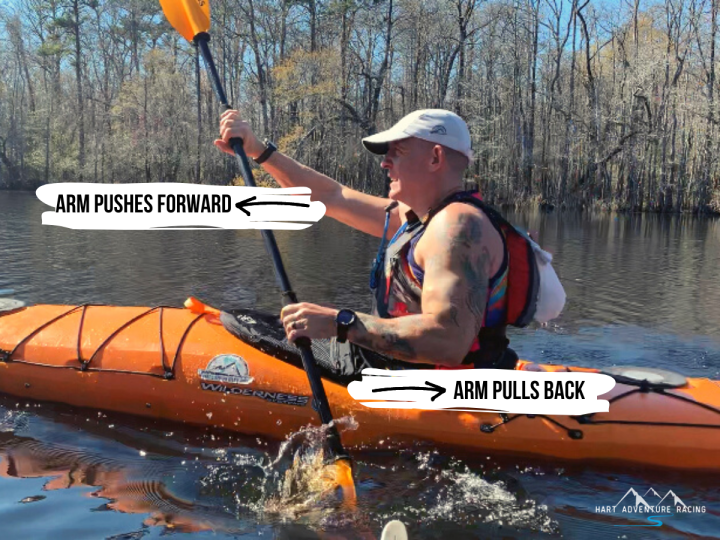Is kayaking good exercise? If you’re thinking about trying it or just curious, you’re not alone. Kayaking isn’t just a fun way to spend time on the water—it’s also a fantastic workout that can help you stay fit and healthy. Whether you’re out for a relaxing paddle or pushing yourself in a more intense kayaking workout, you’re doing your body a favor. Many people don’t realize just how much muscle and energy kayaking uses until they try it themselves.
When you paddle, you’re working your arms, shoulders, back, and core muscles all at once. It’s a full-body workout without the pressure of running or lifting weights. Plus, kayaking boosts your heart health and helps improve endurance. This kind of paddle exercise can be a great alternative if you want a low-impact activity that still challenges your body. Kayaking fitness isn’t just about strength—it’s also about balance, coordination, and enjoying your time on the water. So, if you’re wondering about kayak training or how it fits into your exercise routine, know that it’s a fun and effective way to stay active.
Physical Benefits of Kayaking
Kayaking brings many physical benefits that make it a great way to stay fit and healthy. Here’s how it helps your body:
- Improves Cardiovascular Health
When you paddle, your heart rate increases, which strengthens your heart and lungs. This helps build endurance and supports overall heart health without needing high-impact activities like running. - Builds Upper Body Strength
Paddling works your arms, shoulders, and upper back muscles. Each stroke helps tone and strengthen these areas, making kayaking an effective paddle exercise for your upper body. - Engages Core Muscles
To stay balanced in the kayak, your core muscles — including abs and lower back — are constantly active. This helps improve your posture, stability, and overall strength. - Involves Leg Muscles
Your legs aren’t left out! Pressing your feet against the kayak helps with steering and control, giving your legs a gentle workout as well. - Boosts Flexibility and Balance
Being on the water requires constant adjustments to keep steady. This helps improve your balance and flexibility over time, which is important for injury prevention and everyday movement. - Offers a Full-Body Workout
Because kayaking targets multiple muscle groups and raises your heart rate, it’s a well-rounded exercise that combines strength, cardio, and balance training all at once.
Kayaking is not just enjoyable but also a smart way to build fitness naturally. Whether you’re aiming to improve your strength, endurance, or coordination, this paddle exercise covers it all in one outdoor activity.
Mental and Emotional Benefits of Kayaking
Kayaking isn’t just great for your body—it’s also a boost for your mind and emotions. Spending time on the water gives you a chance to step away from daily stresses and enjoy a peaceful environment. This break can help reduce feelings of anxiety and improve your overall mood.
Being out in nature while kayaking encourages mindfulness. When you focus on your paddle strokes and the gentle movement of the water, it can calm your thoughts and bring mental clarity. Many people find that this connection with nature helps them feel more relaxed and refreshed, which supports better mental health.
Additionally, kayaking offers a sense of accomplishment. Whether you’re mastering a new route or simply enjoying a calm paddle, these moments build confidence and improve your outlook. The combination of fresh air, gentle exercise, and beautiful surroundings makes kayaking a simple way to boost your emotional well-being.
Different Types of Kayaking and Their Exercise Impact
Not all kayaking is the same, and different types offer unique workout benefits. Understanding the kinds of kayaking can help you choose the right style to meet your fitness goals.
- Recreational Kayaking
This is the most common type, perfect for beginners or those who want a relaxed paddle. It offers a gentle workout that improves your overall fitness, especially if you spend longer sessions in calm water. Recreational kayaking helps build endurance and tone muscles without being too intense. - Sea Kayaking
Paddling on open water, like lakes or oceans, provides more challenge. Sea kayaking usually involves longer distances and stronger currents, which means a more intense cardiovascular workout. It also requires better core strength and balance to handle waves and wind. - Whitewater Kayaking
This is for those who like adventure and a serious workout. Navigating rapids takes strength, agility, and quick reflexes. Whitewater kayaking boosts upper body power and improves coordination, making it a demanding but rewarding form of kayak training. - Kayak Fishing
While it may seem less intense, kayak fishing still offers a low-impact exercise option. Paddling to different spots keeps your body moving, and maintaining balance on the kayak helps with core strength. It’s a great choice if you want to combine relaxation with gentle exercise.
Each type of kayaking has something different to offer for your health and fitness. Picking the right one depends on what kind of workout and experience you’re looking for, but all of them contribute to better kayaking fitness and overall well-being.
Kayaking as a Workout: Beginner to Advanced Routines
Kayaking is a flexible workout that fits all fitness levels. Whether you’re new to kayaking or have some experience, you can use it as an effective way to stay active and healthy.
For beginners, it’s best to start slow. Try short paddling sessions on calm water to get comfortable with the basics. This helps build endurance without overwhelming your muscles. A simple beginner kayaking workout could be paddling steadily for 15 to 30 minutes, focusing on smooth strokes and steady breathing. This routine helps improve cardiovascular fitness and strengthens your arms and core gently.
As you progress, you can increase the intensity by paddling longer distances or adding speed intervals. Intermediate paddlers might try 45-minute sessions, mixing steady paddling with faster bursts. This approach boosts stamina and muscle tone more effectively. For those who want a challenge, advanced kayaking workouts include navigating tougher waters, using powerful paddle strokes, and combining kayaking with strength exercises on land, like core workouts or stretching.
Cross-training is also useful to get the most out of your kayak exercise. Adding activities like swimming, running, or yoga can improve your overall fitness and support your kayaking skills. No matter your level, kayaking offers a fun and effective way to build strength, improve endurance, and enjoy time outdoors.
Safety Tips and Equipment for Effective Kayak Exercise
Before starting your kayaking workout, it’s important to focus on safety and have the right gear. Good equipment and safe practices make your paddle exercise more enjoyable and protect you from injury.
- Choose the Right Kayak
Pick a kayak that matches your skill level and the type of paddling you plan to do. Recreational kayaks are stable and great for beginners. If you want more challenge, sea kayaks or whitewater kayaks offer better control for tougher waters. - Wear a Life Jacket (PFD)
A personal flotation device is a must every time you get on the water. Even if you’re confident in your swimming, a life jacket keeps you safe if you tip over or face rough water. - Use a Helmet for Whitewater Kayaking
If you’re kayaking in rapids, wearing a helmet protects your head from rocks and bumps. It’s a simple way to stay safe during more adventurous paddling. - Dress Comfortably
Wear clothes that dry quickly and fit well. This keeps you comfortable and prevents chafing, especially on longer kayak workouts. - Learn Basic Safety Skills
Knowing how to get back in your kayak after a spill and understanding water conditions helps you stay safe. Always check the weather before heading out. - Stay Hydrated and Pace Yourself
Drinking water and taking breaks during your kayak training prevents fatigue. Listening to your body helps you enjoy kayaking while avoiding injury.
By following these safety tips and using the right equipment, your kayaking exercise will be both fun and effective. Staying safe means you can focus on improving your fitness and enjoying every moment on the water.
Frequently Asked Questions About Kayaking as Exercise
If you’re wondering, “Is kayaking good exercise?” you’re not alone. Many people have questions about how kayaking works as a workout and what to expect. Here are some of the most common questions answered clearly to help you get started with confidence.
1. How many calories can you burn kayaking?
Kayaking burns a good number of calories, depending on how hard you paddle and for how long. On average, you can burn between 300 to 500 calories per hour, making it an effective workout for weight management and fitness.
2. Is kayaking good for weight loss?
Yes, kayaking can help with weight loss. It combines cardio and strength training, which boosts metabolism and burns calories. Consistent paddling, along with a healthy diet, can support your weight loss goals.
3. What muscles does kayaking work?
Kayaking primarily works your arms, shoulders, back, and core. Your legs also play a role in steering and balance. This full-body engagement makes it a great exercise for building strength and endurance.
4. Do I need special fitness to start kayaking?
No special fitness level is required to start. Beginners can start with gentle paddling and gradually increase the intensity as they get more comfortable and stronger.
5. How often should I kayak to see fitness benefits?
To see real benefits, try kayaking at least 2 to 3 times a week. Consistency helps build strength, endurance, and improves your kayaking skills.
Kayaking is a great way to stay active, enjoy nature, and get fit. With these answers, you can better understand how to make the most of your kayak training and enjoy the many benefits it offers.
Ending Notes: Is Kayaking Good Exercise?
So, is kayaking good exercise? Absolutely! Kayaking is a great way to get moving and stay healthy. It works many muscles in your body, like your arms, core, back, and legs. At the same time, it helps your heart stay strong. Plus, it doesn’t feel like a workout because you’re outside enjoying the water and fresh air.
Kayaking is good for your mind, too. Being on the water can help you relax and reduce stress. It’s a simple way to feel better both physically and mentally. Whether you paddle slowly or go for longer trips, kayaking can fit your fitness level and goals.
By picking the right kayak and staying safe, you can make kayaking a fun and effective exercise. It’s a workout that feels more like an adventure. If you want a new way to stay active and enjoy nature, kayaking is worth trying!



